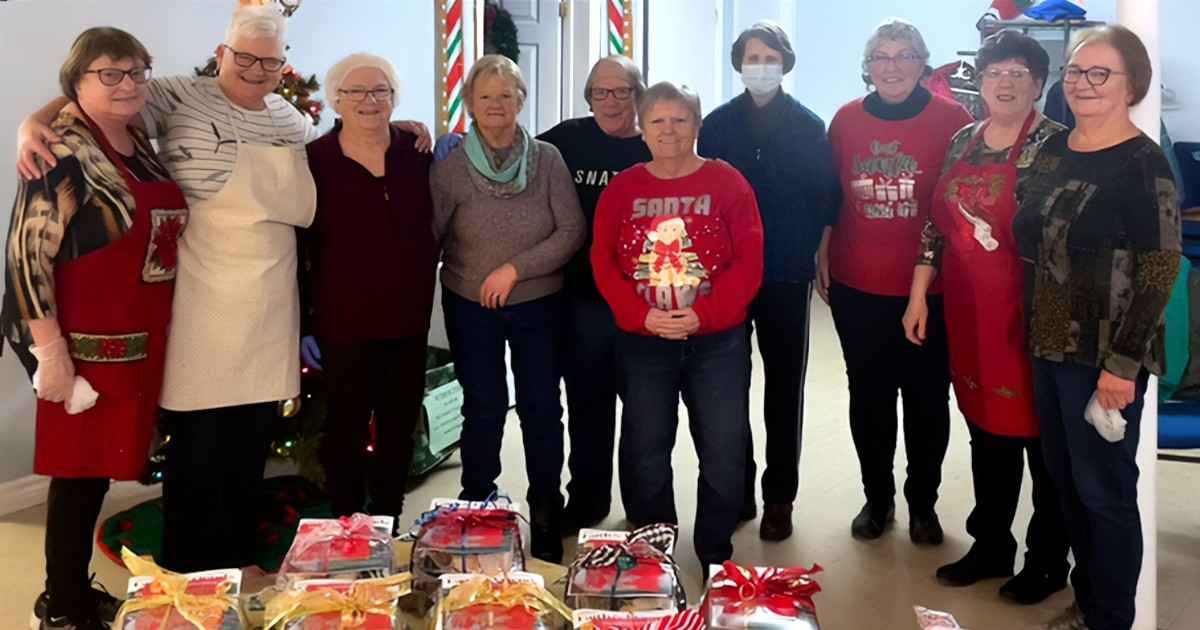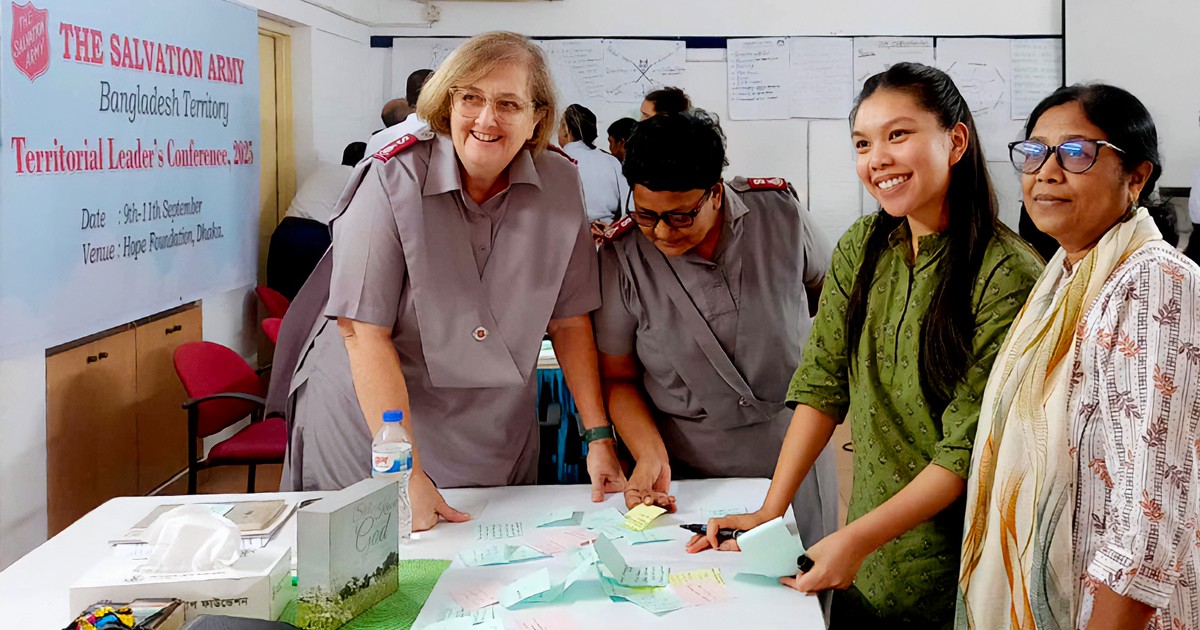 They are commonly referred to as “the Army behind the Army”—the vast network of volunteers who support our work from coast to coast. Chief among them is Andrew Lennox, chairman of the National Advisory Board (NAB).
They are commonly referred to as “the Army behind the Army”—the vast network of volunteers who support our work from coast to coast. Chief among them is Andrew Lennox, chairman of the National Advisory Board (NAB).
As a senior vice-president at Scotiabank, Lennox is responsible for real estate services for the bank's domestic and international real estate portfolio in over 50 countries. He heads a team of experts in strategic portfolio management, leasing, design and facilities management for Scotiabank's global network of 3,000 branches and administrative centres.
For the past 15 years, he's volunteered large amounts of his time as a member of the Board of the Toronto Grace Health Centre, the chairman of the Ontario Central Advisory Board, and most recently the NAB.
Geoff Moulton, assistant editor-in-chief, spoke with Andrew about his commitment to the Army and his hopes for the new board.
Tell us about yourself.
I'm a “career banker” for Scotiabank. Prior to joining the bank, I worked in real estate development and among other things developed Brookfield Place in downtown Toronto and 1000 de La Gauchetière in Montreal. I'm married with three grown children, who are thriving and successful. I keep active playing hockey, wind surfing, golfing and mountain biking.
Describe how the National Advisory Board came into being.
Commissioner William Francis had a clear vision to establish a NAB, much of which was based on his experiences in the United States. Our new board now has a number of similarities. The first is that its members are more subject matter experts rather than fundraisers. The second is that the board was organized to assist and advise the Army's territorial executive members on specific issues of national importance. While fundraising is a critical component of the Army's regional boards through events such as annual breakfasts or golf tournaments, the intent with the national board is to take a broader approach.
We first developed a memorandum of understanding that was the subject of considerable thought and discussion. Its purpose was to outline the responsibilities of the NAB, which include suggesting improvements to the organization's operational efficiency and effectiveness; the development of benchmarks and best-practice standards for service; and the development of supportive relationships between public and private partners. From that we extrapolated what activities the board would be involved with, what subject matter expertise was needed and a list of desirable qualifications for the board. Board members have experience and knowledge in areas such as accounting, legal, marketing and government relations. Most of the members have a national scope in their day-to-day work responsibilities.

Why The Salvation Army? What attracted you and what keeps you committed and energized?
I've been involved in a number of non-profit organizations with varying degrees of success in terms of my own fulfilment. When I got involved with the Army, I was completely taken with how focused it is on its clients. Army workers have great respect for the people they serve and tremendous humility. At the time, I loved the national slogan: “Anyone, Anywhere.” The Army offers its services without any strings attached, and that appealed to me enormously—to help anyone, anywhere, any time with respect and dignity, without asking anything in return is the most selfless and universal any organization can be. The Army has tremendous experience and capability to help the less fortunate in times of crisis. It helps so many people in so many different ways. I think there is no better organization to volunteer with. If I can help in any way, I feel fulfilled.
Is there a particular encounter with the Army that moved you?
One incident early on at the Army's camp in Jackson's Point, Ont., for inner-city children really resonated with me. I'd spent the day at an advisory board function there. As I was leaving, the person responsible for the camp program described how at the end of every two-week period a couple of the children often go “missing.” They are usually found hiding under a bed or behind a building, hoping the bus will leave without them so that they can stay at camp a bit longer and not have to return to their tougher living environments. It was a powerful reminder of the vulnerability of children in our society, as well as the positive and constructive nature of the Army's work.
My experience with many social service organizations is that they can be very territorial; it's too often more about them and their managements than it is about their clients. My experience with the Army, on the other hand, is that its culture, history and religion all work together to ensure an altruistic and authentic spirit of service. Army people live their beliefs rather than telling others how they should live. There's a tremendous humility that's very attractive.
What have you discovered about the Army that the public doesn't realize?
People are constantly surprised at the breadth of the Army's work; how extensive it is. It serves 400 communities, 1.5 million Canadians a year and is the largest provider of homeless beds in Toronto next to government. That's amazing by any standard. Another thing the public might not know is the Army's wonderful history. The more I read about it and think of what the Founders accomplished, the more impressed I am with how clear and effective their mission was. William and Catherine Booth were incredibly successful in developing an effective strategy to meet tremendous social need and creating an organization that has had the flexibility to survive and thrive despite enormous challenges. The Army has been able to rejuvenate itself countless times over its 135-year history.
Salvationists would say that our primary motivation is our faith in God. Do you see that as an advantage?
No question, it is. You couldn't be the great organization you are without it. It does, however, present fundraising challenges for you in a very competitive environment. It's not easy being a religious organization in a society that is increasingly multicultural and multi-faith, a society that seems to have decided proselytizing is undesirable and that faith should be private. The Army needs government and corporate funding to do its good work and the challenge is to find a way to be true to your identity and mission without alienating potential supporters.
Is this an area where the National Advisory Board can support?
Yes. Board members have experience from the “other side” of the table, and many of us have made major funding decisions, including those who work for large corporations and two former deputy ministers from provincial governments who were responsible for health and social services. They understand what the criteria are, how organizations compete for funds and how the Army can best position itself.
How have you seen advisory boards positively impact the Army's work?
In the former Ontario Central Division, the advisory board looked at the Army's property portfolio. The Army owned 300 properties that were in various states of need. The advisory board helped the Army anticipate what the financial demands would be over time and get a handle on how best to organize itself. A committee organized surveys for each of the properties and made recommendations regarding budgets, timelines and priorities. As a result of this collaboration, the Army had better information to make decisions and came away stronger.
Another project was the new Harbour Light in downtown Toronto. The board volunteered to help the Army determine the best approach to redevelopment. We worked with the real estate person at the division, consulted program people from around the territory, helped the Army get government funding and also undertook a capital campaign with the help of Ketchum Canada Inc., which raised $15 million. The Harbour Light's integration of services—helping people with concurrent disorders and offering family counselling and community services—was a big part of the plan.
Where do you think the Army can improve?
The Army is a large and complex organization. Like any big organization, it needs to evolve because the environment in which it operates is constantly changing. Part of the reason the NAB was formed is to help the Army look at places where it could be more efficient and effective. Here are three important areas:
1. Benchmarking—looking at relative performance of the Army and different units within it in delivering its services and management.
2. Best Practices—examining what other organizations do well with an eye for incorporating those things into its own operations.
3. Transparency—being clear and open in terms of processes and outcomes.
The more the Army improves in these areas, the more successful it will be in obtaining funding from corporations and governments and attracting people in every way.
Another thing that's important is the Army brand, which is very powerful because it is uniquely trusted, but it's a challenge to keep that brand strong because the world is evolving. You need to re-educate every generation about your organization. Fortunately, the Army is enormously attractive to older people because its success has been proven. People want safety and reliability. You want to be able to say to your partners, “You can trust us to do what we are promising. We will serve suffering humanity effectively and be careful custodians of your donations.” For a conservative person who wants to support a charity, the Army has an enormous competitive edge.
What are your expectations of the Army?
The Army is very internally focused by nature. To help offset what is sometimes a weakness, we bring an outside set of eyes to challenge the Army and help it look at other opportunities. The challenges that the Army faces are often similar to those of government, other social service organizations or business. The board brings experience to a variety of issues and expects the Army to treat our recommendations seriously and be open and honest with us with respect to its challenges. In return, we will do our best to respond with help and assistance.









Leave a Comment